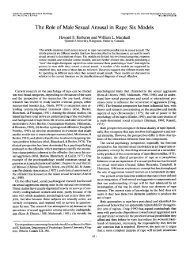Regulation of the dopamine transporter - Addiction Research ...
Regulation of the dopamine transporter - Addiction Research ...
Regulation of the dopamine transporter - Addiction Research ...
Create successful ePaper yourself
Turn your PDF publications into a flip-book with our unique Google optimized e-Paper software.
DAT <strong>Regulation</strong> Schmitt & Reith<br />
surface DAT toward a smaller ratio <strong>of</strong> oligomers to<br />
monomers in what appears to reflect a dissociation<br />
<strong>of</strong> DAT oligomers. 27 Along with <strong>the</strong> reduction <strong>of</strong> <strong>the</strong><br />
fraction <strong>of</strong> oligomerized DAT, <strong>the</strong> amount <strong>of</strong> surface<br />
DAT was decreased, and blocking endocytosis with<br />
phenylarsine oxide or sucrose counteracted <strong>the</strong>se<br />
effects <strong>of</strong> amphetamine. 27 We speculated that DAT<br />
at <strong>the</strong> cell surface is distributed between oligomers<br />
and monomers and that monomers are internalized;<br />
d-amphetamine could promote <strong>the</strong> formation <strong>of</strong><br />
monomers, which <strong>the</strong>n become internalized, reducing<br />
<strong>the</strong> DAT’s presence at <strong>the</strong> surface. When endocytosisispreventedbyanexogenouslyaddedblocker,<br />
monomeric DAT formed by amphetamine remains<br />
at <strong>the</strong> surface and reassociates to form oligomers. In<br />
this scenario, oligomerization and internalization<br />
are linked in <strong>the</strong> effects <strong>of</strong> amphetamine. One can<br />
grasp <strong>the</strong> functional relevance <strong>of</strong> a changed distribution<br />
between oligomerized and monomeric DAT<br />
at <strong>the</strong> surface only once <strong>the</strong> functional properties <strong>of</strong><br />
<strong>the</strong>se forms <strong>of</strong> <strong>the</strong> <strong>transporter</strong> are known.<br />
Substrate-mediated downregulation <strong>of</strong> surface<br />
DAT expression has also been demonstrated with<br />
electrophysiological techniques. In heterologous expression<br />
systems, DAT function is assessed by measuring<br />
<strong>transporter</strong>-associated currents with twoelectrode<br />
voltage clamp recording, whereas in vivo,<br />
microamperometry is used to electrochemically<br />
monitor <strong>dopamine</strong> clearance in real-time. In hDATexpressing<br />
Xenopus oocytes, brief repeated bath perfusion<br />
with <strong>the</strong> substrates <strong>dopamine</strong>, amphetamine<br />
and tyramine (1 min <strong>of</strong> substrate exposure every<br />
5 min, for 1 h in total) gradually reduces DAT<br />
function, as shown by progressive decline <strong>of</strong> substrate<br />
translocation-associated currents. 28 Of <strong>the</strong><br />
three substrates, amphetamine was found to be<br />
<strong>the</strong> most efficacious, producing a significant drop<br />
in current magnitude after <strong>the</strong> fewest repeat perfusions.<br />
This gradual decline in DAT function is<br />
accompanied by a decrease in specific [ 3 H]CFT<br />
binding (Bmax) to intact oocytes, indicating that<br />
<strong>the</strong> reduction in <strong>transporter</strong> currents originates<br />
from loss <strong>of</strong> surface-localized DATs ra<strong>the</strong>r than<br />
modification <strong>of</strong> <strong>the</strong> electrophysiological parameters<br />
<strong>of</strong> individual <strong>transporter</strong>s. Kahlig et al. provided<br />
fur<strong>the</strong>r substantiation <strong>of</strong> this finding—using<br />
a combination <strong>of</strong> fluorescence microscopy and<br />
patch-clamp recording, <strong>the</strong> authors demonstrated<br />
that amphetamine-induced internalization <strong>of</strong> <strong>the</strong><br />
DAT is not paralleled by alteration <strong>of</strong> single-<br />
<strong>transporter</strong> current dynamics, reinforcing <strong>the</strong> idea<br />
that substrate-mediated DAT regulation is <strong>the</strong> result<br />
<strong>of</strong> endocytosis <strong>of</strong> plasmalemmal DAT. 29 In line<br />
with <strong>the</strong> findings in heterologous cells, recurrent<br />
infusion <strong>of</strong> <strong>dopamine</strong> in vivo by reverse microdialysis<br />
(one infusion every 2 min) results in a robust<br />
reduction <strong>of</strong> <strong>dopamine</strong> clearance in rat striatum;<br />
however, no significant change was observed<br />
in <strong>the</strong> nucleus accumbens. 28 This observation implies<br />
that DAT regulation might be an anatomically<br />
specific phenomenon, differing between brain regions.<br />
A similar anatomical discrepancy has been<br />
shown for d-methamphetamine, which decreases<br />
[ 3 H]<strong>dopamine</strong> uptake in striatal synaptosomes but<br />
not in those prepared from <strong>the</strong> nucleus accumbens.<br />
22 A recent study by Richards and Zahniser<br />
also highlights <strong>the</strong> difference between <strong>the</strong> striatum<br />
and <strong>the</strong> nucleus accumbens in terms <strong>of</strong> substrateinduced<br />
DAT regulation: brief (15 min) preincubation<br />
with 20 �M amphetamine reduces <strong>the</strong> V max <strong>of</strong><br />
[ 3 H]<strong>dopamine</strong> uptake in rat striatal synaptosomes<br />
but does not significantly alter <strong>the</strong> V max in synaptosomes<br />
from <strong>the</strong> nucleus accumbens. 30 Curiously,<br />
however, <strong>the</strong> authors found that synaptosomes from<br />
both regions were significantly affected if prepared<br />
from rats treated systemically with 2-mg/kg amphetamine<br />
for 45 min. Fur<strong>the</strong>r inquiry is needed<br />
to delineate potential region-specific differences in<br />
DAT regulation and between in vivo and in vitro<br />
approaches.<br />
Many studies have now conclusively shown<br />
that several substrates, such as <strong>dopamine</strong>, damphetamine,<br />
and d-methamphetamine, can trigger<br />
cytosolic redistribution <strong>of</strong> plasmalemmal DAT.<br />
Nearly all <strong>the</strong>se studies used relatively long substrate<br />
exposure times—anywhere from 15 min to a few<br />
hours. Far less is known about <strong>the</strong> immediate—on<br />
a scale <strong>of</strong> seconds to minutes—effects <strong>of</strong> substrates<br />
on DAT trafficking. A study from <strong>the</strong> Gnegy lab 31<br />
suggests that substrates, such as amphetamine,<br />
may have time-dependent biphasic effects on DAT<br />
membrane trafficking. Using confocal microscopy,<br />
reversible biotinylation, and intact-cell [ 3 H]CFT<br />
(2�-carbomethoxy-3�-(4-fluorophenyl)tropane)<br />
binding, <strong>the</strong> authors demonstrated that acute<br />
exposure to 3 �M d-amphetamine causes an extremely<br />
rapid upregulation in plasmalemmal DAT<br />
expression: surface DAT levels were significantly<br />
increased (on <strong>the</strong> order <strong>of</strong> 60–70%) within 30 s <strong>of</strong><br />
amphetamine treatment and remained elevated for<br />
320 Ann. N.Y. Acad. Sci. 1187 (2010) 316–340 c○ 2010 New York Academy <strong>of</strong> Sciences.










